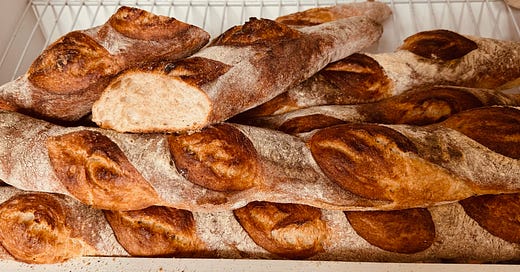NORMAN VAN AKEN’S WORD ON FOOD ©
Today’s word on food is baguettes.
One can simply flash an image of the Eiffel Tower to evoke Paris instantly. It's the monument that offers immediate proof that you are thinking of that fabled place. In the seventeenth century, the Eiffel Tower's role was played by a bridge: the Pont Neuf. But that changed with the famed iron latticed Tower.
In the world of food a baguette might be the image that could conjure of the “City of Light”.
Bread may be near timeless but the words we use to identify them by, less so. The term ‘baguette’ was not used as such until around 1920. The word translates simply enough as a ‘wand’ or a ‘baton’ as in ‘baguette de direction’ also known as a ‘conductor’s baton’.
Why have we not yet seen Peter Sellers as a vain orchestra leader waving a baguette at his symphonic wailers … while consuming one I wonder. I hope for such things.
Like seemingly everything …. baguettes trend in and out. In recent years there was a shift in the zeitgeist when the Vietnamese bánh mì sandwich craze hit. The term bánh mì is derived from the Vietnamese words for bread in general but the mode d’ emploi was definitely the French creation. We only need to remember the French occupation of Vietnam before we waded into that chapter of our American misadventures. The bread used for that delicious and now also American sandwich (we fight… and then we appropriate food customs here)… The baguette took on another level of refinement in the hands of the Vietnamese bakers … with a more airy interior and a shatteringly crispy crust. This was attained by near hourly made baguettes. We have assimilated them sufficiently enough to now have bánh mì hoagies and bánh mì ‘Po Boys’ thanks to the baguette.
While vacationing with my family in Italy some years ago we got inundated with rains. We decided that since vacations were rare to us we’d see if the weather was better elsewhere. We decamped to Cannes smack dab in the South of France. The sun welcomed us! Soon we learned that the oldest food profession is that of the bakers, and France is their home.
Back in the days of Augustus 326 bakers supplied bread to over 1 million Romans. In the 12th Century the guild of bakers was established. The members of the guild were known as tameliers, which meant sifters because they had to sift the flour that was delivered to them. That’s not so bad. Back in 168 BC they were known as pistores or grinders because they had to grind the wheat with a mortar. I’d much rather sift!
To belong to the guild meant insurance too. As long as the bakers delivered fresh bread to the hospital they had priority hospitalization. Bread for Beds!
The baker who supplied free bread to the executioner placed the bread upside down so that the other customers could be sure that the executioner’s hand would not potentially touch theirs. This gave rise to the superstition that it was unlucky to place bread upside down.
When I was a cook in Key West we bought Cuban bread to serve in our breadbaskets. Then, one day, a French bakery came to town. Oooo la-la! We quickly jumped over to the fancier, trendier baguettes. But one thing we found out the baguettes had in common with Cuban bread… Two hours in the Island’s sea rich humidity and they both turned to whiffle bats.
I’m Norman Van Aken and that’s my Word on Food ~~~~~~~~~~~~~~~~~~~~~~~~~~~~~~~~~~~~~~~~~~~~~~~~~~~~~~
© 2024 Norman Van Aken



